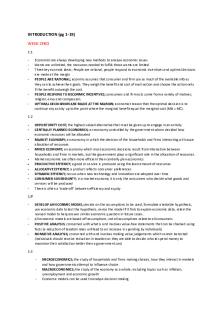Essentials of Understanding Psychology: Chapter 2 Notes PDF

| Title | Essentials of Understanding Psychology: Chapter 2 Notes |
|---|---|
| Author | Adeline Musselman |
| Course | General Psychology |
| Institution | Harrisburg Area Community College |
| Pages | 2 |
| File Size | 72 KB |
| File Type | |
| Total Downloads | 64 |
| Total Views | 207 |
Summary
Class notes for Professor Shoemaker's course in Psych 101, covering chapter 2 of the textbook....
Description
1. The Scientific Method: a. Start with a question: Does TV affect children? b. Develop a theory (broad explanation): Big bang theory, earth revolves around sun c. Form a hypothesis (prediction) d. Run the study e. Publish results so others can repeat study & compare results: Same? Different? 2. Types of Research: a. Archival: looks at data that has already been collected: newspapers, old census data - 1940, ancestry.com b. Naturalistic observation: watch what is happening - disguise, one way mirror, c. Surveys/questionnaires: obtain a lot of information quickly (can sometimes be unreliable, participants do not always answer honestly) d. Case study: in depth look at individual/group e. Correlation study: measure two things (variables) to determine if related i. Positive correlation: both variables increase/decrease together 1. Studying and grades 2. Sleep and productivity 3. Education and income ii. Negative correlation: as one variable increases, the other decreases 1. Partying and grades/productivity 2. Age and strength 3. Temperature and amount of clothing 4. Seesaw iii. Correlation coefficients (numbers): range from +1 to -1 1. Number = strength of the relationship between two variables a. Close to +1 or -1 means a strong relationship b. Close to 0 means weak or no relationship 2. Sign = the direction of the relationship a. + means they increase/decrease together b. - as one goes up, the other goes down iv. Experimental research: formal study, which allows us to say A causes B 1. A) Independent variable: what the experimenter changes between groups a. Ex: different levels of testosterone given to baby chicks 2. B) Dependent variable: what is measured in the experiment a. Ex: change in weight, aggression (pecking order), crowing (when/earliest), development of crowns, etc. as a result 3. Randomly assign participants to groups to guarantee similar groups a. One group may receive placebo (fake treatment) b. Control group receives no treatment v. Latane & Darley (based on Kitty Genovese in 1964): developed theory of
vi.
Diffusion of responsibility - when there are a lot of bystanders, the chances that any will help decreases 1. Used confederates (actors, people working with the experimenter) a. One participant at a time with one actor/confederate b. One participant with two actors c. One participant with five actors i. This group took the longest to help Ethics of research 1. Must be given informed consent to participate 2. Can drop out at any time 3. Deception is okay when it cannot be avoided to achieve accurate result 4. Must receive debriefing after the experiment (offered explanation)...
Similar Free PDFs

Psychology Chapter 2 Notes
- 8 Pages

Essentials of IR Chapter 1
- 4 Pages

Psychology Chapter 9 Notes
- 14 Pages
Popular Institutions
- Tinajero National High School - Annex
- Politeknik Caltex Riau
- Yokohama City University
- SGT University
- University of Al-Qadisiyah
- Divine Word College of Vigan
- Techniek College Rotterdam
- Universidade de Santiago
- Universiti Teknologi MARA Cawangan Johor Kampus Pasir Gudang
- Poltekkes Kemenkes Yogyakarta
- Baguio City National High School
- Colegio san marcos
- preparatoria uno
- Centro de Bachillerato Tecnológico Industrial y de Servicios No. 107
- Dalian Maritime University
- Quang Trung Secondary School
- Colegio Tecnológico en Informática
- Corporación Regional de Educación Superior
- Grupo CEDVA
- Dar Al Uloom University
- Centro de Estudios Preuniversitarios de la Universidad Nacional de Ingeniería
- 上智大学
- Aakash International School, Nuna Majara
- San Felipe Neri Catholic School
- Kang Chiao International School - New Taipei City
- Misamis Occidental National High School
- Institución Educativa Escuela Normal Juan Ladrilleros
- Kolehiyo ng Pantukan
- Batanes State College
- Instituto Continental
- Sekolah Menengah Kejuruan Kesehatan Kaltara (Tarakan)
- Colegio de La Inmaculada Concepcion - Cebu












